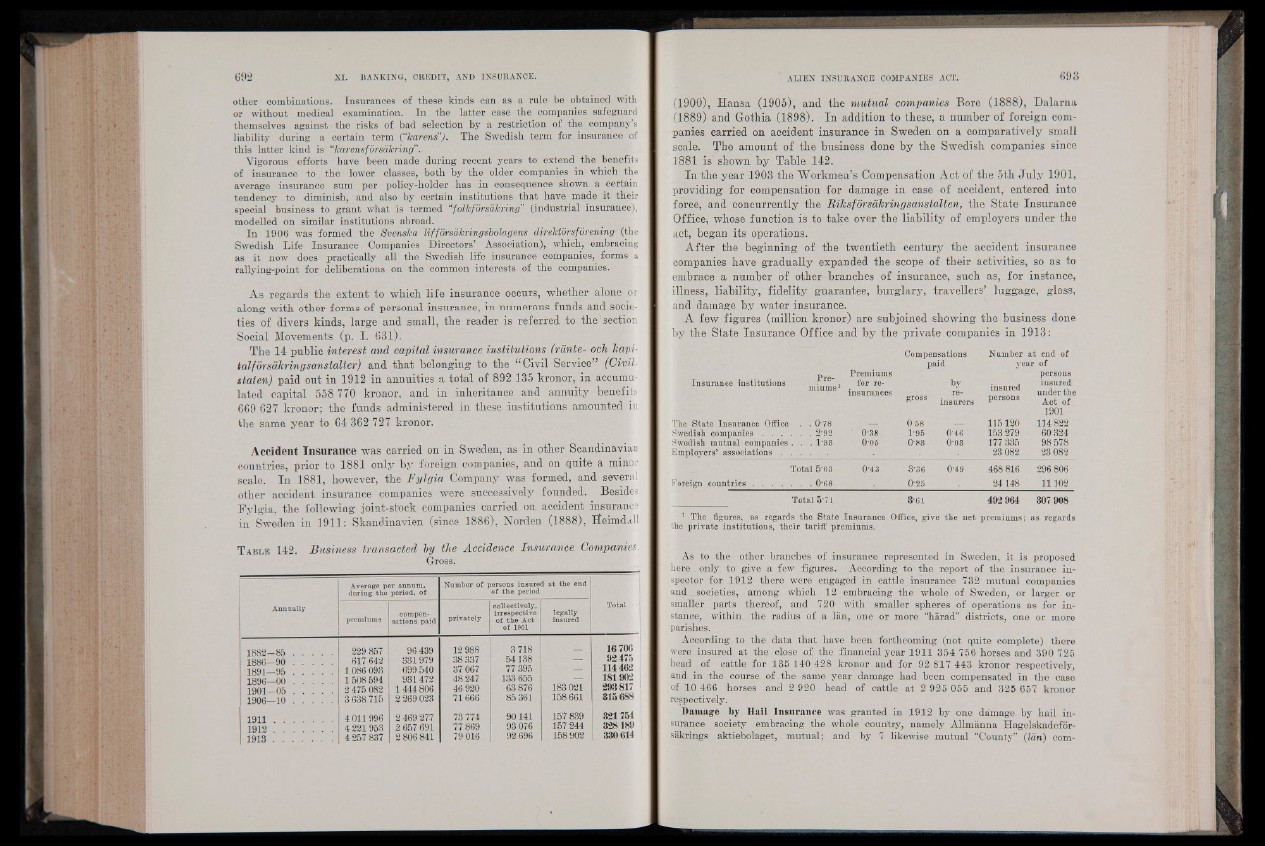
other combinations. Insurances of these kinds can as a rule be obtained with
or without medical examination. In the latter case the companies safeguard
themselves against the risks of bad selection by a restriction of the company’s
liability during a certain term (“harens”). The Swedish term for insurance of
this latter kind is “harensforsakring".
Vigorous efforts have been made during recent years to extend the benefits
of insurance to the lower classes, both by the older companies in which the
average insurance sum per policy-holder has in consequence shown a certain
tendency to diminish, and also by certain institutions that have made it their
special business to grant what is termed “folkfôrsàkring” (industrial insurance),
modelled on similar institutions abroad.
In 1906 was formed the Svenslca liffôrsàlcringsbolagens direMorsforening (the
Swedish Life Insurance Companies Directors’ Association), which, embracing
as it now does practically all the Swedish life insurance companies, forms a
rallying-point for deliberations on the common interests of the companies.
As regards the extent to which life insurance occurs, whether alone or
along with other forms of personal insurance, in numerous funds and societies
of divers kinds, large and small, the reader is referred to the'section
Social Movements (p. I. 631).
The 14 public interest and capital insurance institutions (rante- och hapi-
talforsakringsanstalter) and that belonging to the “Civil Service” (Civil-
staten) paid out in 1912 in annuities a total of 892 135 kronor, in accumulated
capital 558 770 kronor, and in inheritance and annuity benefits
669 627 kronor; the funds administered in these institutions amounted ¡fin
the same year to 64 362 727 kronor.
Accident Insurance was carried on in Sweden, as in other Scandinavian
countries, prior to 1881 only by foreign companies, and on quite a minor
scale. In 1881, however, the Fylgia Company was formed, and several
other accident insurance companies were successively founded. Besides
Fylgia, the following joint-stock companies carried on accident insurance
in Sweden in 1911: Skandinavien (since 1886), Norden (1888), Heimddll
T able 142. Business transacted by the Accidence Insurance Companies.
Gross.
Average per annum,
during the period, of
Number of persons insured a t tbe end
of tb e period
Annually Total
premiums
compensations
paid privately
collectively,
irrespective
of the Act
of 1901
legally
insured
1882—85 ................ 229 857 96 439 12 988 3718 16706
1886—90 ................ 617 642 331979 38 337 54138 92 475
1891—95 ................ 1 086 093 699 540 37 067 77 395 - , £ 1 E 114462
1896—00 ................ 1508594 931472 48 247 133 655 — 181902
1901—05 ................ 2475 082 1 444 806 46 920 63876 183 021 293817
1906—10 ................ 3 638 715 2 269 023 71666 85 361 158 661 315688 !
1 9 1 1 ........................ 4 011996 2 469 277 73774 90141 157 839 321 754
1 9 1 2 ........................ 4 221953 2 657 691 77 869 93076 157 244 328189
1 9 1 3 ........................ 4 257 837 2 806 841 79 016 92 696 158 902 330614
(1900), Hansa (1905), and the mutual companies Bore (1888), Dalarna
(1889) and Gothia (1898). In addition to these, a number of foreign companies
carried on accident insurance in Sweden on a comparatively small
scale. The amount of the business done by the Swedish companies since
1881 is shown by Table 142.
In the year 1903 the Workmen’s Compensation Act of the 5th July 1901,
providing for compensation for damage in case of accident, entered into
force, and concurrently the Riksfôrsakringsanstalten, the State Insurance
Office, whose function is to take over the liability of employers under the
act, began its- operations.
After the beginning of the twentieth century the accident insurance
companies have gradually expanded the scope of their activities, so as to
embrace a number of other branches of insurance, such as, for instance,
illness, liability, fidelity guarantee, burglary, travellers’ luggage, glass,
and damage by water insurance.
A few figures (million kronor) are subjoined showing the business done
by the State Insurance Office and by the private companies in 1913:
Compensations Number at end of
paid year of
Insurance institutions Premiums1
Premiums
for reinsurances
gross
by
reinsurers
insured
persons
persons
insured
under the
Act of
1901
The State Insurance Office
Swedish companies . . .
Swedish mutual companies
Employers’ associations .
. . 0-78
. . . 2'92
. . . 1-33
' 0-38
0-05
0 58
1-95
0;83
0-46
003
115120
153 279
177 335
23 082
114 822
60 324
98 578
23082
Total 5’03 0-43 3-36 0-49 468 816 296 806
Foreign countries . . . . . . . 0-68 0-25 24148 11102
Total 5'71 3-61 492964 307 908
1 The figures, as regards the State Insurance Office, give
the private institutions, their tariff premiums.
the net premiums ; as regards
As to the other branches of insurance represented in Sweden, it is proposed
here only to give a few figures. According to the report of the insurance inspector
for 1912 there were engaged in cattle insurance 732 mutual companies
and societies, among which 12 embracing the whole of Sweden, or larger or
smaller parts thereof, and 720 with smaller spheres of operations as for instance,
within the radius of a lan, one or more “harad” districts, one or more
parishes.
According to the data that have been forthcoming (not quite complete) there
were insured at the close of the financial year 1911 354 756 horses and 390 725
head of cattle for 135 140 428 kronor and for 92 817 443 kronor respectively,
and in the course of the same year damage had been compensated in the case
of 10 466 horses and 2 920 head of cattle at 2 925 055 and 328 657 kronor
respectively.
Damage by Hail Insurance was granted in 1912 by one damage by hail insurance
society embracing the whole country, namely Allmanna Hagelskadefor-
sakrings aktiebolaget, mutual; and by 7 likewise mutual “County” (lan) com